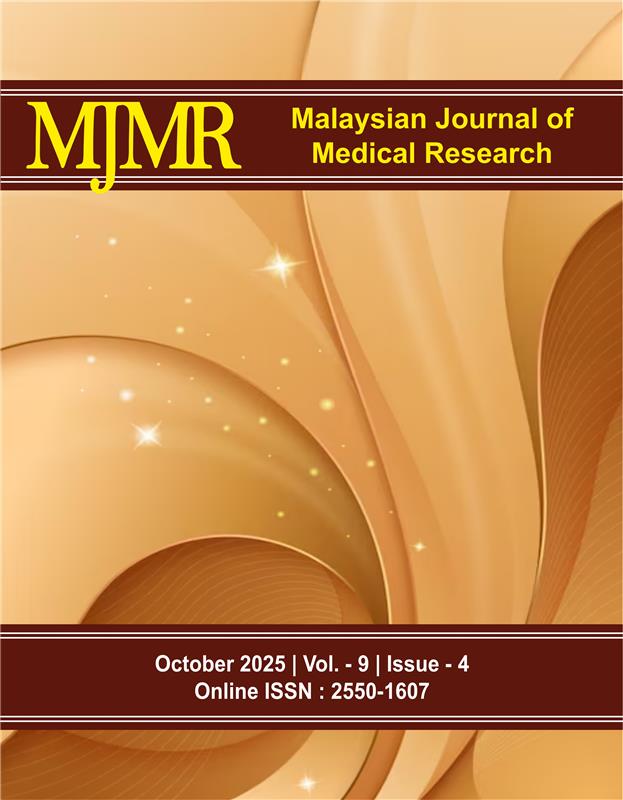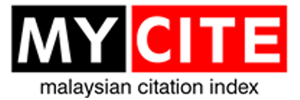The Relationship Between Antimicrobial Dressing Application and the Healing Process of Diabetic Foot Wounds at Griya Sehat
DOI:
https://doi.org/10.31674/mjmr.2025.v09i04.008Abstract
Introduction: Diabetic foot ulcer is one of the complications observed in patients with uncontrolled diabetes mellitus (DM). The World Health Organization (WHO) reported that there were 1.3 million deaths due to diabetes mellitus, while according to the Ministry of Health, the prevalence of diabetes in Indonesia reached 10.9% in 2019 and increased to 11.7% in 2023. One effective treatment method is modern dressing with antimicrobials, which helps inhibit bacterial growth and accelerate wound healing. Objectives: To analyse the relationship between the use of antimicrobial dressings and the healing process of diabetic foot ulcers among patients at Griya Sehat Wocare Bogor. Methods: This study employed a quantitative design with a cross-sectional approach. The sampling technique used was total sampling. The sample size comprised 30 patients with diabetic foot ulcers who received treatment at Griya Wocare Bogor. Data were collected using the Winner Scale assessment sheet and analysed using the Chi-square statistical test. Results: The results showed that the majority of patients used silver antimicrobial dressings. Statistical analysis indicated a significant relationship between the use of antimicrobial dressings and the healing process of diabetic foot ulcers, as demonstrated by the Chi-square test results (p < 0.05). Conclusions: Antimicrobial dressings are associated with accelerated healing of diabetic foot wounds. Therefore, this method is recommended as a standard of care for diabetic foot wounds to reduce the risk of further complications.
Keywords:
Antimicrobial Dressing, Diabetic Foot Ulcer, Diabetes Mellitus, Wound HealingDownloads
References
Amirrah, N. I., Wee, M. F. M. R., Tabata, Y., Bt Hj Idrus, R., Nordin, A., & Fauzi, M. B. (2020). Antibacterial-integrated collagen wound dressing for diabetes-related foot ulcers: An evidence-based review of clinical studies. Polymers, 12(9), 2168. https://doi.org/10.3390/polym12092168
Arisudhana, G. A. B., Partiwi, N. M. N. D., Artana, I. W., & Dewi, S. P. A. A. P. (2022). Perbandingan cadexomer iodine dan silver pada penderita diabetic foot ulcer di praktik mandiri perawatan luka dahlia [A comparison of cadexomer iodine and silver on the healing of diabetic foot ulcers at the dahlia clinic]. Nursing Current: Jurnal Keperawatan, 10(2), 128-141. https://doi.org/10.19166/nc.v10i2.5451
Beaudin, J., Chouinard, M. C., Hudon, É., & Hudon, C. (2025). Factors and strategies influencing integrated self‐management support for people with chronic diseases and common mental disorders: A qualitative study of Canadian primary care nurses' experience. Journal of Advanced Nursing. https://doi.org/10.1111/jan.16892
Creswell, J. W., & Creswell, J. D. (2022). Research design: Qualitative, quantitative, and mixed methods approaches (6th ed.). Thousand Oaks, CA: SAGE Publications. https://www.ucg.ac.me/skladiste/blog_609332/objava_105202/fajlovi/Creswell.pdf
Karina, G. P., Sari, E. A., & Harun, H. (2024). Penerapan Hydrogel dan Antimicrobial Dressing terhadap Penyembuhan Luka dan Sensasi Perifer pada Pasien Gangrene Pedis [Application of Hydrogel and Antimicrobial Dressing on Wound Healing and Peripheral Sensation in Gangrene Pedis Patients]. Jurnal Medika Nusantara, 2(3), 91-105. https://doi.org/10.59680/medika.v2i3.1226
Kementerian Kesehatan Republik Indonesia. (2023). Laporan nasional Riset Kesehatan Dasar (Riskesdas) 2023. Badan Penelitian dan Pengembangan Kesehatan, Kementerian Kesehatan Republik Indonesia [National Basic Health Research (Riskesdas) 2023 Report. Health Research and Development Agency, Ministry of Health of the Republic of Indonesia]. https://kemkes.go.id/app_asset/file_content_download/17169067256655eae5553985.98376730.pdf
Khasanah, N., Kamal, S., & Wahyuningtyas, E. S. (2025). The development of antibacterial dressing in the treatment of Diabetic Foot Ulcer. Journal Indonesian Wound Enterostomal Continence Nurses Association, 1(1), 49-63. https://www.inwecna.org/journal/index.php/jiwecna/article/view/6/6
Lin, H., BoLatai, A., & Wu, N. (2021). Application progress of nano silver dressing in the treatment of diabetic foot. Diabetes, Metabolic Syndrome and Obesity, 4145-4154. https://doi.org/10.2147/DMSO.S330322
Listrikawati, M., Minarti, S. I., Azali, L. M. P., & Prastiwi, F. (2023). Analisis karakteristik luka diabetes mellitus pada pasien DM Tipe 2 di RSUD Karanganyar [Analysis of the characteristics of diabetes mellitus wounds in type 2 DM patients at Karanganyar Regional Hospital]. Jurnal Kesehatan Tambusai, 4(2), 2601-2607. https://doi.org/10.31004/jkt.v4i2.18063
Ma, S., Frecklington, M., & Stewart, S. (2024). The use of antimicrobial dressings for the management of diabetic foot ulcers: A survey of podiatrists in Aotearoa New Zealand. Journal of Foot and Ankle Research, 17(2), e12032. https://doi.org/10.1002/jfa2.12032.
Puspita, T., Kosasih, C. E., Juniarti, N., & Sofiatin, Y. (2025). Peran madu sebagai terapi utama penyembuhan ulkus diabetik pada lansia: Studi kasus [The role of honey as the primary therapy for healing diabetic ulcers in the elderly: A case study]. Jurnal Riset Kesehatan Nasional, 9(1), 43-48. https://doi.org/10.37294/jrkn.v9i1.642
Thomas, D. C., Tsu, C. L., Nain, R. A., Arsat, N., Fun, S. S., & Lah, N. A. S. N. (2021). The role of debridement in wound bed preparation in chronic wound: A narrative review. Annals of Medicine and Surgery, 71, 102876. https://doi.org/10.1016/j.amsu.2021.102876
Vivcharenko, V., Trzaskowska, M., & Przekora, A. (2023). Wound dressing modifications for accelerated healing of infected wounds. International Journal of Molecular Sciences, 24(8), 7193. https://doi.org/10.3390/ijms24087193.
Wang, Y. C., Lee, H. C., Chen, C. L., Kuo, M. C., Ramachandran, S., Chen, R. F., & Kuo, Y. R. (2021). The effects of silver-releasing foam dressings on diabetic foot ulcer healing. Journal of Clinical Medicine, 10(7), 1495. https://doi.org/10.3390/jcm10071495
Wulandari, N. A. (2024). The influence of routine health check-ups, dietary patterns, and clean and healthy living behaviors on the incidence of hypertension and diabetes mellitus. Jurnal Bidang Ilmu Kesehatan, 14(3), 260-267. https://doi.org/10.52643/jbik.v14i3.4531
Published
How to Cite
Issue
Section
License
Copyright (c) 2025 Malaysian Journal of Medical Research (MJMR)

This work is licensed under a Creative Commons Attribution-NonCommercial-NoDerivatives 4.0 International License.























